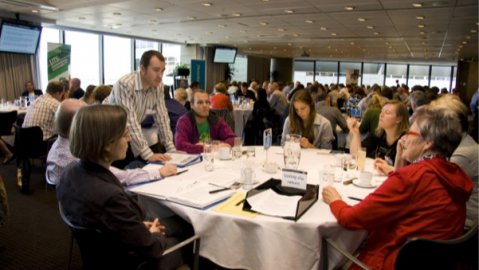Sign up for Big Think on Substack
The most surprising and impactful new stories delivered to your inbox every week, for free.
On January 19-21, the University of Michigan’s Erb Institute and the Union of Concerned Scientists hosted a major summit of more than 100 social scientists, scientists, professionals, and political leaders focused on the topic of “Increasing Public Understanding of Climate Risks and Choices: What We Can Learn from Social Science Research and Practice.”
I was unable to attend because of a conflict here at American University, but for the many of us who were not there, Bud Ward at the Yale Forum on the Media & Climate Change has put together a wonderful compilation of major take away points. Several are likely familiar to readers of this blog.
Also at Ward’s post you can find a summary of important ideas shared by former Republican Congressman Bob Inglis, who is leading an effort to engage conservatives on the issue. Also watch a video of the town hall meeting held at the conference.
Climate change “engagement” strategies and messages need to be specifically targeted to different audiences, including those across a spectrum of acceptance or denial of established climate science evidence;As important as the message to be delivered is the specific messenger delivering that message: An ideal message or speaker for one audience may fall flat before other audiences, notwithstanding possible similarities in the message being delivered;Providing climate science “knowledge” to specific audiences is necessary, but ultimately insufficient if that audience’s emotions, values, ideology, and overall belief systems are not accounted for and addressed. In addressing an audience, speak directly to their aspirations and values, one participant advised, and avoid confounding facts and values. “You’ll otherwise lose the battle for attention …. The ‘should’ claims provide an excuse for the audience to run away.” Basing your views primarily on the much-ballyhooed “knowledge deficit,” “science illiteracy,” “knowledge gap” assumptions leads only to a fool’s errand.Three critical steps in devising a climate communications strategy: A clear sense of “present realities”; a clear sense of where we want to go; and a roadmap to get there.Avoid an attitude of “We’re right. They’re wrong. How can we change them?”Try to avoid the audience’s conflating a policy response, for instance “cap-and-trade,” with the foundational scientific evidence. They can understand and support the latter while objecting to the former. “Embed sustainability into the DNA of civilization itself,” one expert suggested, so citizens “would almost have to make a conscious decision NOT to be sustainable.”Adopt an attitude of “amnesty,” another suggested, for those who, for instance, have put people at high risks by building in flood plains and vulnerable areas.People conform to information processing consistent with their cultures, one expert social scientist said. “Your processing is motivated to affirm the dominant view of your group; you search for affirming information, and you best remember affirming information.” Another: “Open communications by reaffirming the listener’s worth … come as a friend, a friendly communicator.Find connections, and tap into cultural values that speak to that audience … People will defend their sense of self before they will change their behavior.” In a hero-oriented society, make it heroic “to act to protect the environment,” and give people “a reason to become heroes in a climate protection culture.” Another suggestion: “Start with where they [the audience] are, not with where you are.”Consider focusing on climate change risks to motivate particular audiences to take concrete actions. The insurance example — home owners annually buy fire insurance not because we think our home will burn down, but rather because we don’t know that it won’t — is one example of effective risk story-telling.In the case of those who might be considered to be “conspiracy theorists” (for instance, suspicious of an agenda they see as seeking to deprive rights and freedoms) providing more information may well be counterproductive: the more information provided a conspiracy theorist … the bigger the conspiracy they perceive.The public at large cannot be expected to “study” and absorb or substantially understand climate science. Instead, they will “take their cues” from the political leaders and activists or spokespersons they most admire, whether it be an Al Gore or Bill McKibben or a Rush Limbaugh.Public understanding and acceptance that there is a strong consensus on climate science across the scientific community is crucial, but for now too large a segment of the public is unaware that such a consensus indeed exists.Constructive policy action on an issue like climate change can be driven by a majority of public opinion, and consensus does not mean “unanimity.” The “let me persuade you” model is flawed in addressing the general public. Better to think of the model of a jury trial: “We don’t have to convince the opposing lawyer, but rather the jury,” one speaker emphasized.The public is unrealistic in thinking the scientific community can substantially reduce or eliminate legitimate uncertainty, but uncertainty (which cuts both ways) is not an excuse for inaction in the face of overwhelming evidence.Repetition of key points by respected messengers is crucial. For instance: Climate change is real; it’s the result of human activities this time; the scientific community agrees; and there are things that can be done to mitigate its worst impacts.In addressing faith communities, several speakers said that notwithstanding strong scientific evidence, an effective message can be that “You should care because God cares.” “God cares for those suffering from desertification,” a speaker emphasized. “Think about it theologically …. God will hold us accountable.” Another speaker: “Love God and love your neighbors as yourself,” and if we love our neighbors — defined to include future generations — we do not pollute or foul their space.A positive attitude, and the very word “solutions” can be invaluable. “Industry loves focusing on ‘solutions,’” an industry representative advised. Another approach discussed as being helpful in capturing corporate interests: engage them on notions of emerging technologies and long-term business and employment opportunities.A question raised: Should there be a climate social sciences “extension service” analogous to the agricultural extension service?Consider the notion not of “global warming” but rather of “local warming.” How would your community look in a four-degrees warmer climate? What impacts on water supply, on local farming? What would be involved in adapting to it? How would it be financed? What winners, what losers? Etc.Just as climate scientists are not “monolithic,” neither are social scientists. Each field has its own prestigious journals, its own institutional pressures (e.g., tenure pressures), its own culture.See Also:
The Science of Science Communication: National Academies Event Examines Our Inconvenient Minds and Identities
What’s Next for Science Communication? Promising Directions and Emerging Best Practices
Reading List and Videos for American University Seminar on Science and Environmental Communication
How Scientists View the Public, the Media,, and the Political Process
Understanding Public Opinion and Participation in the Climate Change Debate
Reframing Climate Change as a Public Health Problem
Science Journalists Online: Shifting Roles and Emerging Practices
Study Maps Relationship Between Cable News and Climate Change Perceptions
America’s Peak Oil Perceptions
Sign up for Big Think on Substack
The most surprising and impactful new stories delivered to your inbox every week, for free.






